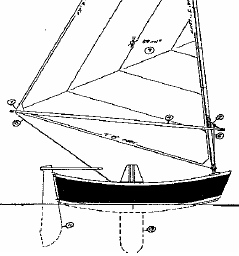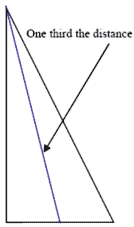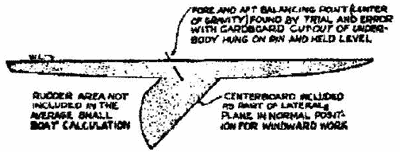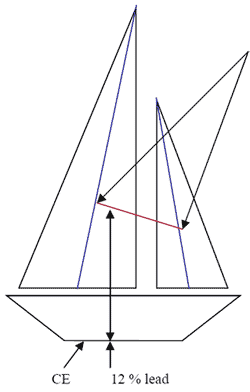This article will deal with the balance of boats—masts, sails, and
lateral resistance.
The basic concept is that when the wind is caught by the sails,
its force is transferred to the center of the boat. If, say, you put
the sail all the way forward with no board or rudder, the boat
would spin around like some teenager doing a wheelie in a Bonneville
while he listens to the Beach Boys. If you want to irritate
the older generation or sling off the stern the chucklehead who’s
dating your daughter, fine. Boat spinning has a certain shameless,
mindless fun to it.
But if you want to get anywhere, the sail and the boat will have
to work together. Joshua Slocum often said he spent many hours
away from the rudder because Spray was so perfectly balanced.
What this means in a general sense is that the sail is directly over
the deepest part of the hull, and both of them are in the middle of
the boat.
 This is Philip Bolger’s
Elegant Punt. It’s easy to
see the leeboard directly
below the sail. If there
were no rudder the boat
would sail at its fastest,
and in theory, straight.
In order to get to that
point, you need fasting,
prayer, and perfect balance. This is Philip Bolger’s
Elegant Punt. It’s easy to
see the leeboard directly
below the sail. If there
were no rudder the boat
would sail at its fastest,
and in theory, straight.
In order to get to that
point, you need fasting,
prayer, and perfect balance.
The problem is, as the
crusty old guy with the beard and pipe on the waterfront says,
there ain’t no formula in the sand for getting perfect balance. In
the past, designers just starting out copied previous boats. Some
learned more from this than others, but somewhere laying in the
bilge were the good guidelines.
If you take a lawn chair with a mint julep in one hand, put the
lawn chair in the river and sit down, you’re going to go floating
down the river along with the water. But what if you want to
float to the other side of the river? Then you’ll have to stick your
other hand down in the water, to resist it in order to go sideways
across to the other bank.
If you hold an umbrella with one hand while your other hand is
in the water, to get across the river, the wind in the umbrella will
push you against the water. With your hand resisting that water, you’ll get across the river at an angle. This is the principle of
wind into a sail while the shape of the boat resists the water.
Throughout the centuries we’ve learned if the resistence to the
water is at the bow, the stern just swings around to smash other
boats. Fun, sure, but you pay while the judge laughs. Now if
you put the resistence at the stern, things get better. The boat
steers some, but not enough to get anywhere before dark. So
back ages ago, some genius put the resistence in the center of
the boat, and voila, he got his boat across the river.
Moses in the bushel basket floating down the Nile is one
thing. Christopher Columbus waiting for a favorable wind is
better, but what’s best is when your hand is directly below the
umbrella.
As a result, designers have figured out how to get the resistance
of the boat directly below the center of the sail. These
things are not perfect, since a sail catching the wind fills out,
changing its shape. And when the boat leans over, it changes
the shape of the hull in the water. This stuff isn’t exact but it’s
close enough.
The lean of the wind on the umbrella is called, center of effort.
The pressure of the water on the lawn chair is called center
of lateral resistance. When one is directly above the other,
fill the glass with another julep because life is good.
 What designers do is draw the sail as a triangle. Then they
find the midway point along any one of the three sides. From
this point they draw a straight line to the angle opposite that
side. The measure 1/3 of the way from the side used. That
will be the center of the triangle, reasonably close to the actual
center of effort. So far this is pretty simple, and fairly accurate. What designers do is draw the sail as a triangle. Then they
find the midway point along any one of the three sides. From
this point they draw a straight line to the angle opposite that
side. The measure 1/3 of the way from the side used. That
will be the center of the triangle, reasonably close to the actual
center of effort. So far this is pretty simple, and fairly accurate.
But now for the hull. The center
of lateral resistence is the midpoint
of the waterline length.
This, however, is not so exact.
Boats differ in shape, some have
keels while some have centerboards.
Probably the easiest way to get
the general point of lateral resistence
is to draw the profile of the
hull on a flat piece of paper and
then balance it with a pin through
the mid point. Where it balances
is the point of lateral resistence.
Below is an illustration of the pinned paper technique. It
probably works well enough with small boats, especially flatbottomed
boats with one topside panel.

In Skene’s Elements of Boat Design, Mr. Skene gives the
mathematical formulas for finding balance exactly. It
amounts to creating squares of wetted surface and adding
them together. When you get a grand total, you divide it. I
don’t do that, since I can’t even balance my checkbook.
What is relevant is that the center of effort should be forward
of the center of lateral resistance. This is called lead,
pronounced, leed. Flat-bottomed boats often have lead of
15 % of their waterline length.
Usually designers will either not consider the rudder as lateral
plane, put it in, or put the forward third of the rudden in.
Ted Brewer says he uses the forward third of the rudder as
part of the lateral plane.
But what if you have more than one sail? You’ll have to
put your spectacles on and crunch numbers. Now if you
want to know how to add, subtract or divide, don’t be sending
me any emails. I was an English major, I know how to
stick pins in cardboard.
Think of your two sails as a chubby boy and a skinny boy
on the see-saw. That skinny little blister will have to be further
away from the pivot point to balance out the chubmeister.
So it is with the sails. The bigger sail is given a sail area
called ‘weight.’ The distance from its center of effort to an
axis we’ll choose is called its ‘arm.’ So weight times arm
equals a number called ‘moment.’
These terms are our booklearning. You know stuff now.
So let’s draw two sails and crunch some numbers on them to
figure the cente of effort for a main and jib daysailor.
- The main will be 100 square feet of sail.
- The jib will be 25 square feet of sail.
 The axis is at the main’s center of effort, so the distance between
the CE of the main and the CE of the jib is 10 feet. The axis is at the main’s center of effort, so the distance between
the CE of the main and the CE of the jib is 10 feet.
Where the two
blue lines intersect
the red line are the
two CE.
If we take the sail
area times the arm,
we get the moment.
So since the SA of
the main is 100, and
the axis is its own
CE, then it is 100
times 0=0. Nothing
from nothing
leaves nothing, as
the song says. This
much I can get.
Now if we take the
sail area of the jib—
25 square feet—and
multiply it by its
arm, which is 10
feet, we get 250. So with the total sail area, 125 feet, divided
it by our 250, we get the answer as 2 inches. Here we measure
forward from the main CE along the red line 2 inches and that
is our lead. If the boat is 20 feet long, 2” is a lead of 12 %.
If there were no lead at all, the boat would want to head toward
the wind, hard. This is called ‘weather helm.’ Some is
good, more is less good. If the boat wants to head away from
the wind this is ‘lee helm.’ This is not good, and at times with
big ships in storms has led to capsizing.
Lee helm means the adjusted CE is too far forward of the
center of lateral resistance. Weather helm means the adjusted
CE is aft of the lateral resistance. For the sake of clarity I have
not shown the CLR, which would presumably be between the
adjusted CE and the mast. In any case, the rudder must be
designed with lead in mind.
From the designer’s point of view, there is a great deal more
to this than a flat sheet of paper. How the topsides curve, how
many panels, is it carvel, and the center of gravity—all these
things go into a balanced boat.
I have to admit I admire those old ship designers who could
get all this right on clipper ships, schooners, brigantines.
That’s plenty of addition. Or maybe the addition was the rum.
*** |

